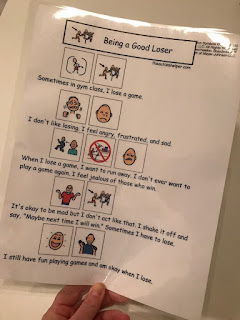Specials classes, or Integrated Arts, can be found in many of the schools we coach. These classes often include PE, Music, Library, or Art. In some districts you may also find Technology or Computer Lab or STEM. Specials teachers have the unique role of serving all students in the building across multiple grade levels. This is no easy task! Additionally, they teach students at all ability levels so they are responsible for differentiating their content to best meet the needs of each student. To assist in planning for this differentiation, today's Around Town Round Up highlights examples from across the Miami Valley that can be used in Meeting the Needs of Students with Autism During Specials using The Ziggurat Model.
The Ziggurat Model
The Ziggurat Model was developed by Dr. Ruth Aspy and Dr. Barry Grossman as a framework for designing comprehensive interventions for individuals with complex needs. When coaching teams, we often refer to this model to help in prioritizing interventions and making sure all of the student's needs are met. For more information on The Ziggurat Model visit:
www.texasautism.com.
Sensory Differences and Biological Needs
Consider the sensory demands of the specials environment. How will the student be impacted by auditory, visual, or tactile input? Many students with autism may struggle with loud noises, changing acoustics, wide open floor plans, visual clutter, unexpected physical contact, or touching certain textures. Consult with the student's OT for their specific sensory needs. For more information about each sensory system don't miss our
Sensory Systems Overview.
 |
| Music Room with Acoustic Panels |
 |
| Child Using Rubber Gloves While Painting |
 |
Noise-cancelling Headphones for Students
Trotwood ELC, Trotwood |
Reinforcement
Students with autism are often unmotivated by customary rewards. During Specials, look for ways to engage the student either through incorporating special interests (such as technology), creating hands-on learning opportunities, or developing a specific reinforcement system.
 |
Rock Climbing Wall
Eric Bostick
Beverly Gardens Elementary, Mad River |
 |
Online Music Game from QuaverMusic.com
Pam George
Washington Primary, Piqua |
 |
| PE Repetition Checklist Reinforcement System |
 |
PE Behavior Contract
Laurie Maravetz
Schaefer Middle School, Springfield |
Structure and Visual/Tactile Supports
Structure can be calming and organizing for individuals with autism because they understand what to expect and can predict the outcome. This is especially important during Specials class because typically these classes do not occur daily throughout the year (often biweekly or quarterly) so it is difficult to establish and remember a daily routine. Also, individuals with autism often process visual information twice as fast as their neurotypical peers. Therefore, incorporating structure and visual supports to the Specials classroom can ease anxiety and help students with autism participate more readily. There are a variety of ways to incorporate these supports including:
incorporating visual and physical boundaries to structure the physical environment,
 |
Art Table Labels
Lindsay Carter
Kleptz ELC, Northmont |
 |
Colored Spots for Musical Instruments
Pam Horner-Sherman
Demmitt Elementary, Vandalia |
 |
Numbered Assigned Seats
Pam George
Washington Primary, Piqua |
 |
Colored Dot Assigned Seats
Pam Horner-Sherman
Demmitt Elementary, Vandalia |
 |
Art Supply OrganizationDebi Gnau
Mad River Early Childhood Center, Mad River |
using visual sequences to structure the class time,
 |
Art Class Daily Visual Schedule
Lindsay Carter
Kleptz ELC, Northmont |
 |
Individual Specials Schedule
Heather Balkcom
Washington Primary, Piqua |
using visuals to communicate activity expectations,
 |
Art Activity Visual Sequences
Lindsay Carter
Kleptz ELC, Northmont |
 |
Daily PE Stretches Visual Sequence
Eric Bostick
Beverly Gardens Elementary, Mad River |
 |
Lyric Visual Supports
Pam George
Washington Primary, Piqua |
and providing models and exemplars.
 |
Painting Idea Folder
Lindsay Carter
Kleptz ELC, Northmont |
Task Demands
For many students Specials, or Integrated Arts, can be a favorite part of the day. They often enjoy the freedom to engage in fun activities and interact with friends. However, this time can often be challenging for our students with autism who struggle to manage the changing sensory, social, and task demands. Prioritize the purpose of Specials for the individual student. Are they working towards mastery of the academic content or are they focusing on social interaction? Consider ways to reduce demands so that the student with autism can be more successful. Some ideas include:
- Reduce social demands by allowing the student to work independently while peers work in groups
- Reduce task demands by allowing the student to do mastered, repetitive tasks during group activities
- Reduce sensory demands by incorporating sensory supports
- Consider alternative tasks that can be completed if the student becomes too overwhelmed in class
- Reduce the length of time the student attends Specials
- Pair the student with a familiar or preferred peer buddy to provide assistance and modeling
Skills to Teach
Sometimes there are specific skills practiced during Specials that the student may need additional direct instruction and practice with. Consider all of the skills needed to be successful with class activities. Determine which skills the student may still need help with. Ask related service providers to prime students on needed skills. The Speech and Language Pathologist can teach important social skills like waiting and turn taking while the Occupational Therapist may provide ideas for addressing sensory needs or teach prerequisite fine motor skills, and the Physical Therapist can assist with motor skills needed for PE activities and Music dances.
 |
Waiting and Turn Taking Visual SupportsKaty Philpot
Rosa Parks ELC, Dayton |
 |
Mistake Options Visual
Lindsay Carter
Kleptz ELC, Northmont
|
Specials can also be a great time to incorporate multisensory lessons to accompany material learned in class. Collaborate with general education teachers and intervention specialist to develop cross-curricular activities for students to help with generalization of core concepts and skills.
 |
Emotions Art ProjectsAngela Shelton
Rosa Parks ELC, Dayton |



























































